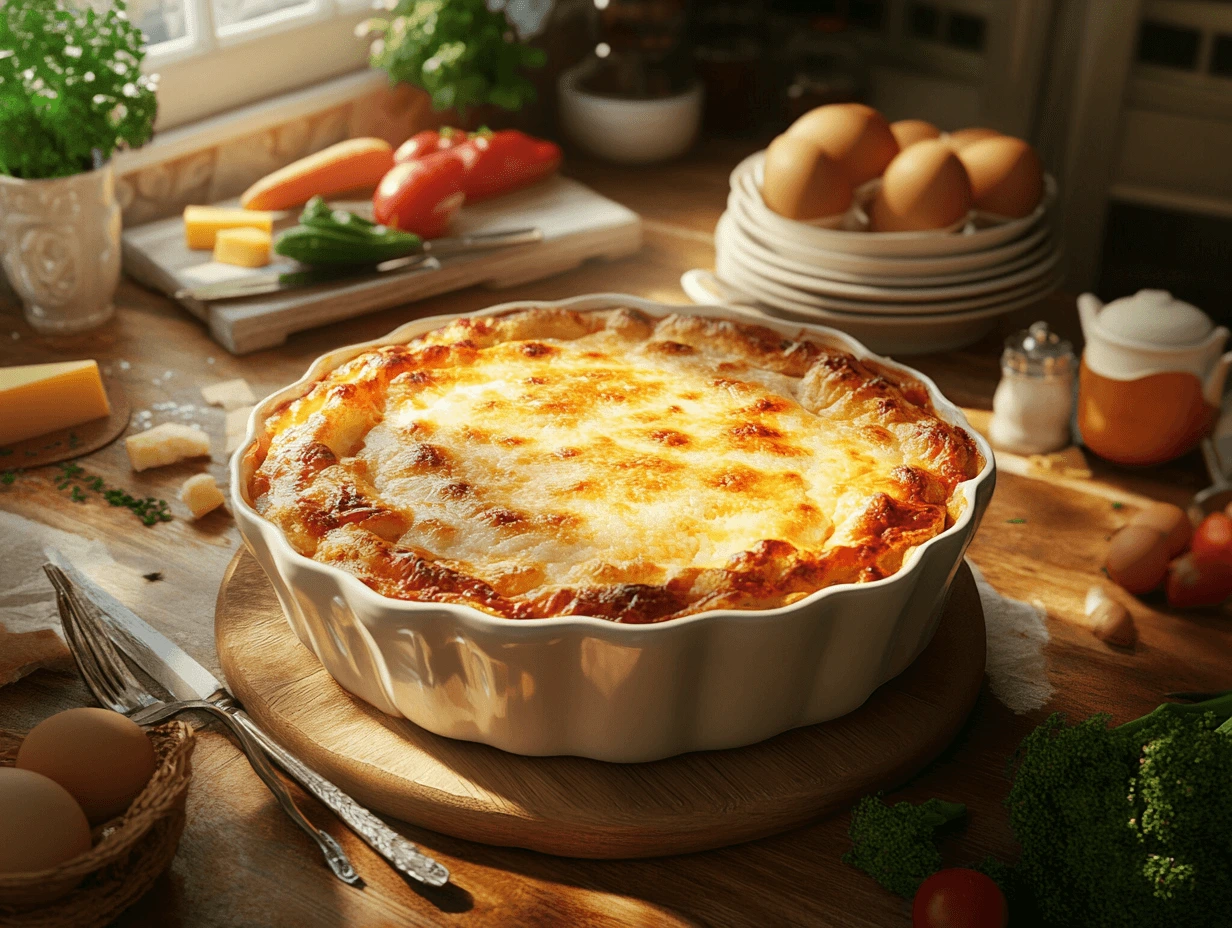Table of contents
Breakfast casseroles are a popular dish for brunches, family gatherings, and meal prepping. They are hearty, versatile, and easy to customize with ingredients like eggs, bread, vegetables, and cheese. However, one common issue frustrates many home cooks: Why is my breakfast casserole soggy?
A soggy breakfast casserole can ruin your meal, leaving it wet, mushy, and unappetizing. But don’t worry! Understanding the reasons behind this issue and implementing expert fixes can help you achieve a perfectly baked casserole every time. This article will explore the causes of soggy casseroles, how to fix them, and tips for preventing them in the future.
Common Causes of a Soggy Breakfast Casserole
Overuse of Liquid Ingredients
One of the main answers to “Why is my breakfast casserole soggy?” lies in the use of too much liquid. Ingredients like milk, cream, or broth are essential to bind the casserole’s components, but using them in excess overwhelms the dish.
For instance, recipes often call for a mixture of eggs and milk. While this combination creates a custard-like texture when baked, using too much milk can leave the casserole wet in the center. Similarly, adding broth or cream without adjusting other liquids can throw off the balance.
Solution: Aim for a ratio of about 1/4 cup of milk or cream per egg. This guideline ensures the mixture binds the ingredients without saturating them.
Undercooking the Casserole
Another culprit is undercooking. Breakfast casseroles often have thick layers of ingredients that require even and thorough cooking. If the casserole isn’t cooked long enough, the liquid components don’t have time to set properly, resulting in a wet and gooey texture.
Signs of Undercooking:
- The center jiggles excessively when shaken.
- The top looks cooked, but the middle appears raw or overly wet.
Solution: Bake the casserole until a knife inserted into the center comes out clean, or use a thermometer to ensure the internal temperature reaches at least 160°F (71°C).
Using Wet Ingredients Without Draining
Vegetables like spinach, mushrooms, and tomatoes, as well as proteins like sausage, can introduce extra moisture into a casserole. These ingredients naturally release water as they cook, especially if added raw.
Solution: Always sauté or cook vegetables and proteins beforehand to remove excess water. For example, cook spinach until wilted and squeeze out any remaining liquid before adding it to the casserole.
Incorrect Baking Dish Choice
The size and material of your baking dish can impact how the casserole bakes. A dish that’s too small may compress ingredients, trapping moisture, while an overly large dish can spread the mixture too thinly, leading to uneven cooking.
Solution: Use a dish appropriate for the recipe’s quantity, typically a 9×13-inch glass or ceramic baking dish for standard casseroles. Glass and ceramic retain heat well and encourage even cooking.
Skipping the Resting Period
Allowing a casserole to rest after baking is crucial. Resting lets the residual heat set the ingredients, especially the egg mixture. Cutting into the casserole immediately after baking can cause it to appear soggy, even if it’s fully cooked.
Solution: Let the casserole rest for at least 10–15 minutes before serving. This step ensures a firm and sliceable texture.
How to Fix a Soggy Breakfast Casserole

Now that we’ve identified the common causes of a soggy breakfast casserole, let’s explore practical steps to fix or prevent the problem. Whether you’re in the middle of cooking or trying to salvage an already-baked dish, these techniques will help you achieve a perfect result.
Adjusting Liquids During Preparation
The right ratio of liquid to solid ingredients is key to preventing sogginess. As mentioned earlier, using about 1/4 cup of milk or cream per egg is a reliable rule of thumb. If you’re adding ingredients with high water content (like vegetables or juicy proteins), adjust the liquid in the egg mixture accordingly.
Alternative Ingredients:
- Substitute heavy cream for milk for a richer, thicker base.
- Use unsweetened Greek yogurt instead of milk to add creaminess without excess liquid.
Tip: If you’re unsure about the liquid balance, err on the side of less. You can always add more cheese or cream for moisture once the casserole has finished baking.
Precooking Ingredients
Raw vegetables and proteins are common culprits for introducing excess water into your casserole. Precooking these ingredients ensures they won’t release additional moisture during baking.
How to Precook Ingredients:
- Vegetables: Sauté mushrooms, onions, peppers, or zucchini in a pan until their liquid has evaporated. For leafy greens like spinach, cook until wilted, then squeeze out the excess liquid using a clean kitchen towel.
- Proteins: Brown sausage, bacon, or ham in a skillet and drain off any grease.
- Bread or Starch: If your recipe includes bread, let it sit out overnight to dry or lightly toast it. Stale bread absorbs liquid more effectively, preventing sogginess.
Proper Layering Techniques
Layering your ingredients strategically can help manage moisture distribution. For example, placing drier ingredients like bread or potatoes at the bottom creates a barrier that absorbs liquid from the custard mixture.
Layering Tips:
- Start with a base layer of bread, hash browns, or another starch.
- Add precooked proteins and vegetables.
- Pour the egg mixture evenly over the top.
- Sprinkle cheese as the final layer to lock in flavors and prevent evaporation.
Choosing the Right Cooking Temperature and Time
Cooking temperature and time play a significant role in the final texture of your casserole. Baking at too low a temperature may leave the center undercooked, while too high a temperature can overcook the edges before the center sets.
Best Practices:
- Bake at 350°F (175°C) for most breakfast casseroles.
- Use an oven thermometer to ensure your oven is calibrated correctly.
- Check the casserole’s doneness by inserting a knife into the center. It should come out clean, and the top should be golden brown.
Salvaging a Soggy Casserole
If your casserole turns out soggy despite your best efforts, don’t panic! There are ways to salvage it:
- Return It to the Oven: Cover the casserole loosely with foil and bake for an additional 10–15 minutes to help evaporate excess moisture.
- Reheat Individual Slices: Heat slices in a skillet over low heat to remove moisture.
- Transform It: Repurpose the casserole into a breakfast hash by mixing it with sautéed potatoes or reheating it in a frying pan.
FAQs About Soggy Breakfast Casseroles

Can I salvage a soggy casserole after it’s cooked?
Yes, a soggy casserole can often be saved. Start by returning it to the oven at 350°F (175°C). Cover the dish loosely with foil to avoid burning the top, and bake for an additional 10–15 minutes. This will help evaporate excess moisture and set the ingredients. If you’re in a rush, try reheating individual slices in a skillet over low heat, which can also help to reduce sogginess.
What can I do to prevent watery vegetables in casseroles?
Watery vegetables are a common cause of soggy casseroles. To prevent this:
- Sauté vegetables like mushrooms, zucchini, and peppers until their liquid has evaporated.
- For leafy greens like spinach, cook until wilted, then squeeze out the remaining liquid using a clean kitchen towel.
- Avoid adding raw tomatoes, as they release significant moisture when cooked. If you must use tomatoes, deseed and dice them finely.
Should I cover or uncover my casserole while baking?
Whether to cover a casserole depends on the recipe. Covering traps steam, which is useful for preventing the top from overbaking but can contribute to sogginess. Uncovering during the last 10–15 minutes of baking allows the top to crisp and excess moisture to evaporate. For best results, follow these guidelines:
- Cover the casserole for the first half of the baking time to retain moisture.
- Uncover it in the final stage for a golden, crispy top.
How do I know if my casserole is fully cooked?
A fully cooked breakfast casserole should have a firm, custard-like texture without excessive jiggle in the center. To test doneness:
- Insert a knife or skewer into the center. It should come out clean.
- Check that the internal temperature reaches 160°F (71°C) using a food thermometer.
- The edges should be set, and the top should be slightly puffed and golden brown.
What are some common substitutions for dairy in casseroles?
If you’re avoiding dairy or looking for alternatives, there are several substitutions that work well without compromising the casserole’s texture:
- Use unsweetened almond milk, coconut milk, or oat milk instead of regular milk.
- Swap heavy cream with cashew cream or blended silken tofu for a creamy texture.
- Replace cheese with dairy-free shredded cheese alternatives or nutritional yeast for added flavor.
Can I make a breakfast casserole ahead of time without it getting soggy?
Yes, breakfast casseroles are great for meal prep, but proper storage and preparation are key to avoiding sogginess:
- Assemble the casserole the night before but do not bake it. Store it covered in the refrigerator.
- Before baking, let the casserole sit at room temperature for about 15–20 minutes to ensure even cooking.
- If pre-cooked, reheat slices individually to maintain their texture, or bake the entire casserole again at a low temperature to remove moisture.
Conclusion
A perfectly baked breakfast casserole is a delightful centerpiece for any meal, whether it’s a casual family brunch or a special occasion. However, dealing with a soggy casserole can feel frustrating and disheartening. By understanding the common causes—such as overuse of liquid, undercooking, or using wet ingredients—and applying preventative measures, you can ensure your casserole comes out firm, flavorful, and perfectly set.
From adjusting the liquid-to-solid ratio to precooking vegetables and proteins, every step plays a crucial role in achieving the right consistency. Additionally, selecting the appropriate baking dish, layering ingredients properly, and letting the casserole rest after baking can make a significant difference.
If sogginess does occur, don’t fret—there are practical solutions, like reheating or repurposing the casserole, that can save the dish and still satisfy hungry guests. Armed with these tips and techniques, you’re now ready to tackle any breakfast casserole recipe with confidence.
Remember, the key to success lies in preparation, timing, and practice. So, don’t be afraid to experiment and adjust recipes to suit your preferences. A little effort goes a long way in creating a casserole that’s sure to impress and become a favorite at your table!





